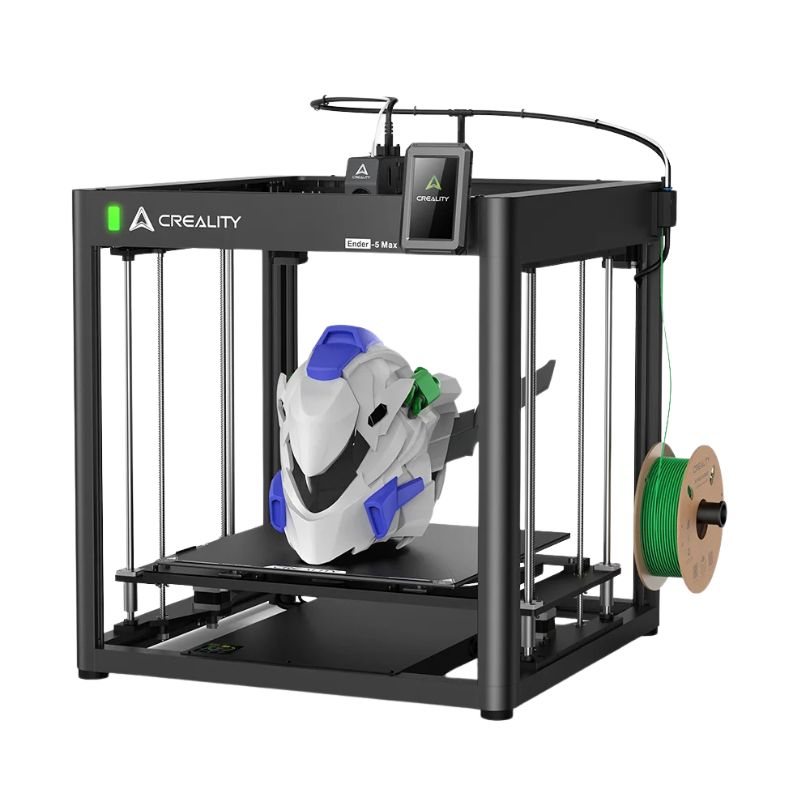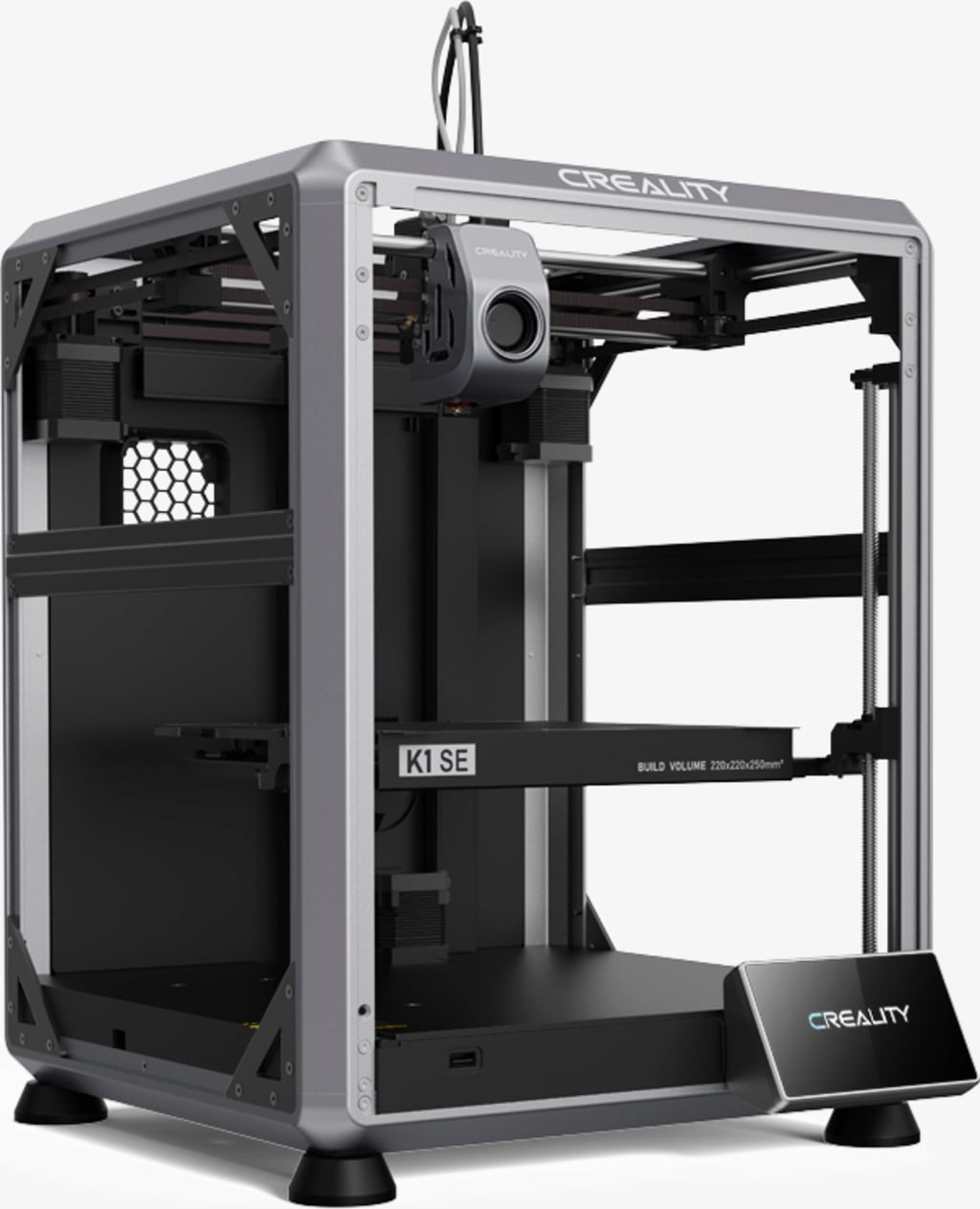Compare Ender 5 Max vs K1 SE
Comparison between the best 3D printers
Choose the best 3D printer at the best price. The cheapest 3D printers are here.
Buy a 3D printer here with 3D Fila.
 |
 |
|
| Model | Ender 5 Max |
K1 SE |
| Printing Material | Filament | Filament |
| Buy Filament for Creality Ender 5 Max | Buy Filament forCreality 3D K1 SE | |
| Estimated price | $769,00 | $349,00 |
| Manufacturer | Creality | Creality 3D |
| Release Year | 2025 | 2023 |
| Print Volume [mm] | 400x400x400 | 220x220x250 |
| Printer Size [mm] | 649x721x850 | 355x355x480 |
| Weight [kg] | 25,9 | 10,24 |
| Power Loss Recovery | YES | YES |
| Enclosed printer | NO | NO |
| Bed Leveling | Automatic | Automatic |
| Filament End Sensor | YES | YES |
| Bed type | Heated | Heated |
| Power supply system | Direct Drive | Direct Drive |
| Standard nozzle | 0,4 | 0,4 |
| Maximum Nozzle Temperature [°C] | 300 | 300 |
| Maximum Bed Temperature [°C] | 100 | 100 |
| Maximum printing speed [mm/s] | 700 | 600 |
| Filament holder | YES | YES |
| Camera for supervision | YES | YES |
| Recommended filaments | Hyper PLA/PLA/PETG/TPU95A/ABS/ASA/PLA-CF/PA/PLA-Silk | Hyper PLA, PLA, PETG, PET, TPU |
| Recommended slicers | Creality Print 5.1 | Creality Print; Cura, Simplify3D e PrusaSlicer |
| Maximum Resolution [mm] | 0,1 | 0,1 |
| Processor | ||
| Display | Touchscreen 4,3'' | Display touchscreen 4,3'' |
| Power Supply | 1250 W | 110/220V / 350W |
| Connectivity | USB, Wifi | Ethernet / USB / Wi-Fi |
| Operating systems | Windows | Windows, Mac, Linux |
| Date of registration in the system | 2025-02-18 | 2023-08-26 |
| Release date | 2025 | 2023 |
| Extra features | The Ender 5 Max by Creality features a 400 x 400 x 400 mm build volume, a rigid aluminum frame, and 36-point auto bed leveling. With speeds up to 700 mm/s, it boasts a hardened dual-gear extruder and a 1000W heated bed, reaching 80°C in just 200 seconds. It supports remote management via WLAN, a tri-color status indicator, and quiet operation, making it ideal for high-precision, high-productivity 3D printing. | The Creality K1 SE is a high-speed 3D printer with CoreXY system, capable of printing at up to 600mm/s with acceleration of 20000mm/s². It has a dual-gear extruder, easy-to-replace tri-metal nozzle, automatic leveling, and advanced features such as vibration reduction algorithms and intelligent operation. Its rigid cast aluminum frame ensures stability, while the open-source Klipper-based system offers freedom for customization. It is pre-assembled for a simplified and fast user experience. |
| Support for multiple colors and materials (AMS and CFS) | NO | NO |
Notes * |
||
| Cost-benefit | 7 / 10 | 7 / 10 |
| Hardware | 5 / 10 | 4 / 10 |
| Tela | . | . |
| Print volume | 4 / 10 | 3 / 10 |
| Performance | 6 / 10 | 5 / 10 |
Conclusion |
| In comparing the Creality Ender 5 Max and the Creality 3D K1 SE, both models present compelling features tailored to different user needs in the 3D printing landscape. The Ender 5 Max stands out due to its larger print volume of 400x400x400 mm, making it suitable for larger projects or more intricate designs. Its maximum printing speed reaches 700 mm/s, which, combined with a robust aluminum frame and advanced bed leveling capabilities, positions it as a solid choice for high-precision work. The model also offers a wider range of recommended filaments, thus facilitating versatility in printing materials. On the other hand, the K1 SE, though it has a smaller print volume of 220x220x250 mm, benefits from a modern CoreXY system that enables faster printing with impressive acceleration and vibration reduction algorithms. This printer is designed for a simplified user experience with its pre-assembled construct and customizable open-source system. Its focus on speed and efficiency makes it a desirable option for users who prioritize quick turnaround times. When examining cost, the Ender 5 Max, while more expensive, provides superior build dimensions and speed, appealing to more intensive projects, whereas the K1 SE offers a more budget-friendly entry point, making it accessible for beginners or those with less frequent printing needs. Ultimately, the decision between the two models will rest on specific user requirements: if larger volume and speed are paramount, the Ender 5 Max is the better investment, while the K1 SE presents an excellent balance of performance and affordability for less demanding tasks. Both devices score similarly in cost-benefit, suggesting that users will be satisfied with either choice, depending on their unique needs in the world of 3D printing. |

